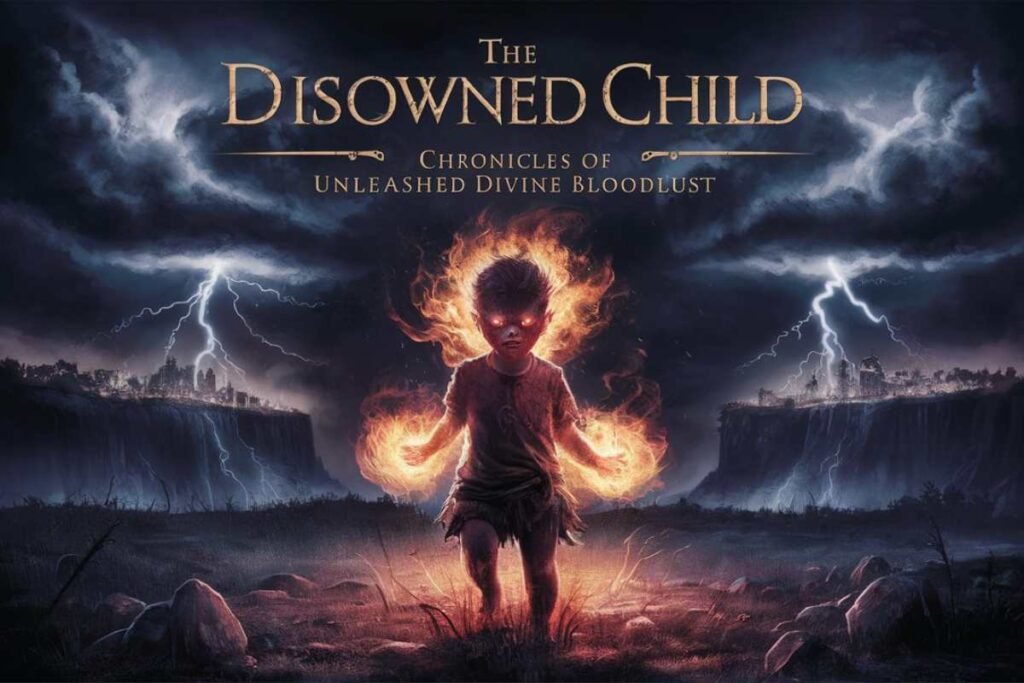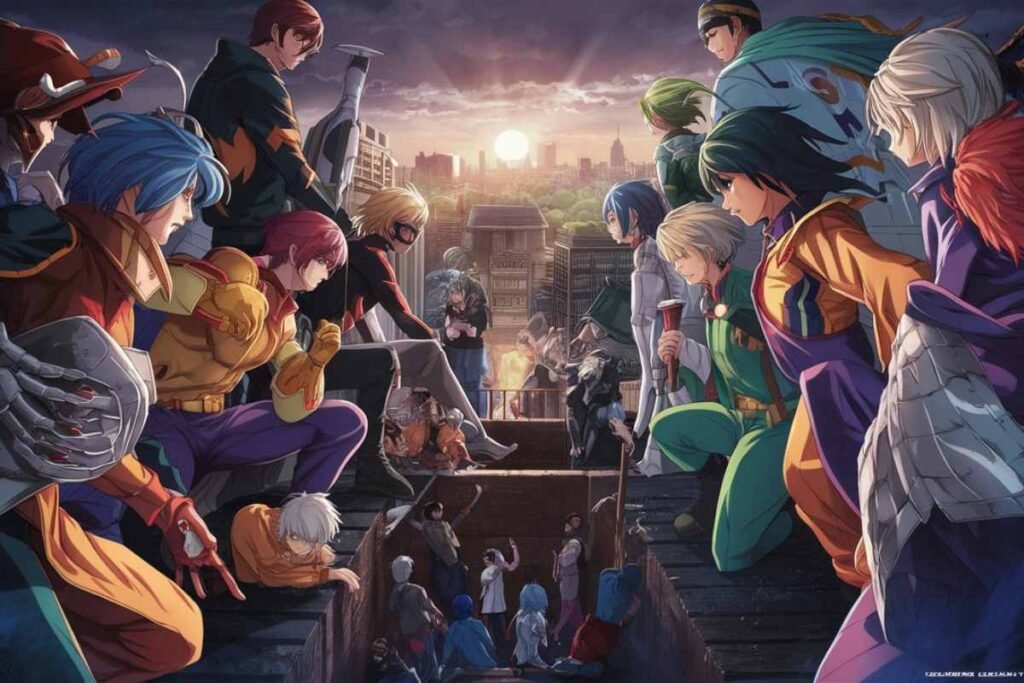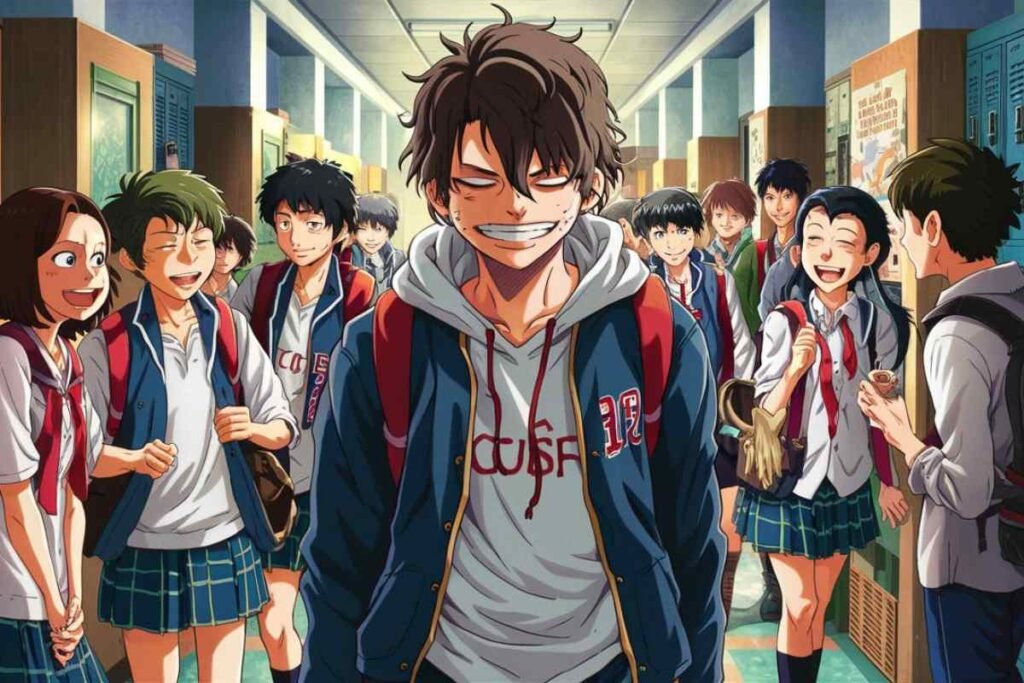Table of Contents
In the vast expanse of mythological narratives and dark fantasy literature, few tales resonate as deeply as The Disowned Child: Chronicles Of Unleashed Divine Bloodlust.
This saga explores the timeless themes of divine heritage, familial betrayal, and the destructive allure of power.
Through the journey of Arin, a disowned demigod, readers are taken on an emotional and philosophical rollercoaster that examines the consequences of divine negligence and the primal human need for identity and revenge.
The Foundation of the Tale

The Protagonist: Arin
At the heart of this epic tale is Arin, a child born from the union of a mortal woman and the celestial being, Draxis.
Arin’s life is marked from birth by his divine lineage and the rejection that comes with it. Abandoned by his celestial father and raised in the harsh realities of the mortal world, Arin embodies the pain of rejection and the relentless drive for vengeance.
His journey from a forsaken child to a powerful avenger fuels the narrative, offering a profound exploration of his internal and external struggles.
Divine Heritage and Familial Betrayal
Arin’s story begins with his divine origins. Draxis, a powerful celestial being, falls in love with a mortal woman, Zephira.
Their union, though forbidden, results in the birth of Arin. However, the joy of his birth is short-lived as Draxis, pressured by celestial laws and fearing the wrath of the gods, disowns Arin and banishes him to the mortal realm.
This act of betrayal sets the stage for Arin’s journey, infusing him with a burning desire for revenge against his divine father and the celestial order that cast him aside.
The Mortal Struggle
Raised by his mortal mother, Zephira, in a world that neither understands nor accepts his divine heritage, Arin faces a life of hardship and ostracization.
The mortal realm is unforgiving, and Arin’s unique abilities often set him apart, making him a target of fear and suspicion.
This early life of struggle and rejection shapes Arin’s character, hardening him and instilling in him a fierce determination to prove his worth and exact vengeance on those who wronged him.
Key Themes

Divine Abandonment and Vengeance
The central theme of “The Disowned Child” is the profound impact of divine abandonment and the ensuing quest for vengeance.
Arin’s rejection by his celestial father is not just a personal betrayal but a representation of the larger neglect of divine beings towards their mortal offspring.
This theme is explored through Arin’s relentless pursuit of his father, driven by a desire to make Draxis and the celestial order face the consequences of their actions.
Identity and Duality
Arin’s journey is as much about self-discovery as it is about revenge. His dual nature, being both mortal and divine, presents a constant internal conflict.
This duality is a source of both strength and torment, as Arin struggles to reconcile his mortal emotions with his divine abilities.
His quest for identity is a key driver of the narrative, exploring the complexities of belonging and the search for purpose in a world that rejects him.
The Corruption of Power
As Arin hones his divine abilities, the narrative delves into the corrupting influence of power. His divine bloodlust, a primal force within him, grows stronger with each act of vengeance.
This theme examines how power, even when wielded for justifiable reasons, can lead to moral corruption and destructive consequences.
Arin’s journey serves as a cautionary tale about the dangers of allowing vengeance and power to consume one’s humanity.
Plot Summary

The Fall
The saga begins with Arin’s dramatic fall from celestial grace. Born to Zephira and Draxis, Arin’s existence is a direct defiance of celestial laws.
Draxis, fearing retribution from the gods, disowns Arin and casts him into the mortal realm. This act of abandonment marks the beginning of Arin’s journey, filled with anger, confusion, and a burning desire for revenge.
The initial chapters depict Arin’s early life, highlighting his struggles to survive in a world that fears and shuns him.
The Ascent
Under the guidance of Eldric, a seasoned mortal warrior who recognizes Arin’s potential, Arin begins to unlock his divine abilities.
Eldric becomes a father figure and mentor, teaching Arin to harness his powers and control his bloodlust.
This period of growth is marked by intense training and self-discovery, as Arin learns to channel his anger and power towards his ultimate goal of confronting Draxis.
The bond between Arin and Eldric adds depth to the narrative, highlighting themes of mentorship, loyalty, and the search for belonging.
The Confrontation
The climax of the story is Arin’s epic confrontation with his celestial father, Draxis. This battle is not just a physical clash but a symbolic struggle against the divine injustice that Arin has endured.
The confrontation is intense and emotional, with Arin confronting not only Draxis but also the celestial order that allowed his abandonment.
This pivotal moment forces Arin to face his deepest fears and desires, culminating in a powerful and transformative encounter.
The Resolution
The saga concludes with Arin at a crossroads, having vanquished Draxis but left with the weight of his actions. He stands at the threshold of two paths: continuing his quest for vengeance against the celestial order or seeking redemption and a new purpose in the mortal realm.
This resolution is both poignant and thought-provoking, exploring the themes of forgiveness, redemption, and the enduring struggle for identity.
Arin’s ultimate choice shapes the future of both the mortal and divine realms, leaving a lasting impact on the world.
The Disowned Child Archetype in Literature

Historical Context
The archetype of the disowned child has deep roots in literature and mythology, symbolizing the universal human experience of rejection, resilience, and the quest for identity.
From ancient myths to modern tales, the disowned child embodies the struggles and triumphs of those cast aside by society or family.
Ancient Myths
In Greek mythology, the tale of Perseus, the demigod son of Zeus, mirrors Arin’s journey. Perseus, abandoned and left to fend for himself, embarks on epic quests to prove his worth and fulfill his destiny.
Similarly, Hercules, another son of Zeus, faces immense trials and tribulations, navigating the complexities of his dual nature and divine heritage.
Literary Classics
In classic literature, characters like Jane Eyre from Charlotte Brontë’s novel and Heathcliff from Emily Brontë’s “Wuthering Heights” embody the disowned child archetype.
Jane Eyre’s journey from an orphaned, mistreated child to a strong, independent woman highlights themes of resilience and self-discovery.
Heathcliff’s tale, marked by rejection and a thirst for revenge, parallels Arin’s struggle against those who wronged him.
Modern Interpretations
In contemporary literature and media, characters like Harry Potter and Ender Wiggin reflect the enduring appeal of the disowned child narrative.
Harry Potter, burdened by the legacy of his powerful lineage and rejected by his relatives, overcomes immense adversity to embrace his destiny.
Ender Wiggin, from Orson Scott Card’s “Ender’s Game,” rises from an outcast to a hero, using his unique abilities to save humanity.
Thematic Exploration

Resilience and Self-Discovery
The narrative of “The Disowned Child” celebrates the resilience of the human spirit. Despite facing rejection and adversity, Arin’s journey is a testament to the power of self-discovery and the indomitable will to overcome challenges.
His transformation from a forsaken child to a powerful avenger underscores the importance of perseverance and inner strength.
Identity and Belonging
Central to Arin’s journey is the quest for identity and belonging. Torn between his mortal and divine heritage, Arin’s struggle to find his place in the world resonates with readers who grapple with their own sense of belonging.
His journey highlights the complexities of identity and the human need for acceptance and purpose.
Power and Corruption
Arin’s growing power and bloodlust serve as a cautionary tale about the corrupting influence of power. As he seeks vengeance, he must confront the moral implications of his actions and the potential for power to consume his humanity.
This theme explores the delicate balance between using power for justice and succumbing to its destructive allure.
Cultural and Literary Significance

Universal Themes
“The Disowned Child: Chronicles Of Unleashed Divine Bloodlust” taps into universal themes that resonate across cultures and time periods.
The disowned child archetype, with its emphasis on resilience, identity, and the struggle for power, speaks to fundamental aspects of the human experience.
Mythological Resonance
The saga’s mythological elements draw from a rich tradition of storytelling that spans ancient civilizations.
By incorporating elements of Greek, Norse, and other mythologies, the narrative creates a tapestry of cultural references that enrich the story and provide deeper layers of meaning.
Modern Relevance
In a contemporary context, the story of Arin reflects modern struggles with identity, belonging, and the impact of power dynamics.
The themes explored in the narrative resonate with current social and political issues, offering a compelling commentary on the human condition.
Detailed Character Analysis

Arin
Arin’s character is a complex blend of strength, vulnerability, and moral ambiguity. His journey from a rejected child to a powerful avenger is marked by internal and external conflicts.
Arin’s struggle with his dual nature—mortal emotions and divine abilities—adds depth to his character, making him a relatable and compelling protagonist.
His quest for vengeance is driven by deep-seated pain and a desire for justice, yet it also forces him to confront the darker aspects of his nature.
Zephira
Zephira, Arin’s mortal mother, is a poignant figure in the narrative. Her love and sacrifice provide the emotional foundation for Arin’s journey.
Despite her mortal limitations, Zephira’s strength and resilience play a crucial role in shaping Arin’s character.
Her unwavering support and guidance serve as a counterbalance to Arin’s divine struggles, highlighting the enduring power of maternal love.
Draxis
Draxis, the celestial father, embodies the complexities of divine beings and their impact on the mortal realm.
His rejection of Arin is driven by fear and the rigid laws of the celestial order, yet it also reflects his inner conflict and vulnerability.
Draxis’s eventual confrontation with Arin forces him to face the consequences of his actions and the pain he inflicted on his son. This character’s arc explores themes of guilt, redemption, and the responsibility of power.
Eldric
Eldric, the seasoned mortal warrior, serves as a mentor and father figure to Arin. His wisdom and experience provide crucial guidance, helping Arin to harness his powers and control his bloodlust.
Eldric’s relationship with Arin adds emotional depth to the narrative, highlighting themes of mentorship, loyalty, and the search for belonging. His character represents the human capacity for compassion and the importance of guiding the next generation.
The World-Building

The Mortal Realm
The mortal realm in “The Disowned Child” is a harsh and unforgiving landscape, reflecting the struggles and challenges faced by Arin.
The detailed world-building creates a vivid backdrop for the narrative, with diverse settings ranging from desolate wastelands to bustling cities.
This realm’s intricate social and political dynamics add complexity to the story, highlighting the impact of divine actions on mortal lives.
The Celestial Realm
The celestial realm, in contrast, is depicted as a place of immense power and rigid order. The gods and celestial beings operate under strict laws, their actions governed by a desire to maintain balance and avoid conflict.
This realm’s portrayal adds a layer of mythological grandeur to the narrative, providing a stark contrast to the mortal world and emphasizing the divide between mortals and divine beings.
Interplay Between Realms
The interplay between the mortal and celestial realms is a key aspect of the narrative, driving the plot and character motivations.
Arin’s journey navigates the complex dynamics between these worlds, exploring the impact of divine actions on mortal lives and the potential for change and redemption.
This interplay adds depth to the story, highlighting the interconnectedness of all beings and the consequences of power and neglect.
Symbolism and Imagery

Bloodlust
Arin’s divine bloodlust serves as a powerful symbol throughout the narrative, representing his primal drive for vengeance and the corrupting influence of power.
This bloodlust is both a source of strength and a potential downfall, reflecting the dual nature of Arin’s identity and the moral complexities of his journey.
The Disowned Child
The image of the disowned child, cast aside and struggling for acceptance, is a central motif in the story.
This symbolism speaks to universal themes of rejection, resilience, and the search for identity, resonating with readers on a deep emotional level.
The Celestial and Mortal Divide
The stark contrast between the celestial and mortal realms serves as a visual representation of the narrative’s central conflict.
This divide emphasizes the themes of abandonment, power dynamics, and the struggle for justice and belonging.
Conclusion
The Disowned Child: Chronicles Of Unleashed Divine Bloodlust masterfully intertwines mythological grandeur with profound human emotion, crafting a narrative that explores the complexities of divine heritage, identity, and the corrupting allure of power.
Through Arin’s tumultuous journey from abandonment to vengeance, the tale delves into the universal themes of resilience, self-discovery, and the quest for justice.
The rich world-building, complex characters, and symbolic depth create a resonant and thought-provoking saga that speaks to the timeless struggle for belonging and the enduring impact of familial betrayal and divine neglect.
This epic story not only captivates with its dark fantasy allure but also offers a poignant reflection on the human condition and the eternal search for identity and purpose.
FAQs
Who is the protagonist of The Disowned Child: Chronicles Of Unleashed Divine Bloodlust?
The protagonist is Arin, a disowned demigod born from the union of a mortal woman, Zephira, and the celestial being, Draxis.
What are the main themes of the story?
The main themes include divine abandonment, vengeance, identity, duality, and the corrupting influence of power.
What motivates Arin’s quest for vengeance?
Arin is driven by the rejection and betrayal from his celestial father, Draxis, and the larger celestial order that cast him aside.
Who mentors Arin in harnessing his powers?
Arin is mentored by Eldric, a seasoned mortal warrior who becomes a father figure to him.
How does Arin’s dual nature affect his journey?
Arin’s dual nature, being both mortal and divine, creates a constant internal conflict, adding complexity to his quest for identity and revenge.
What role does Zephira play in Arin’s life?
Zephira, Arin’s mortal mother, provides emotional support, love, and resilience, shaping his character and grounding his divine struggles.
What is the significance of Arin’s divine bloodlust?
Arin’s divine bloodlust symbolizes his primal drive for vengeance and the potential moral corruption from wielding immense power.


